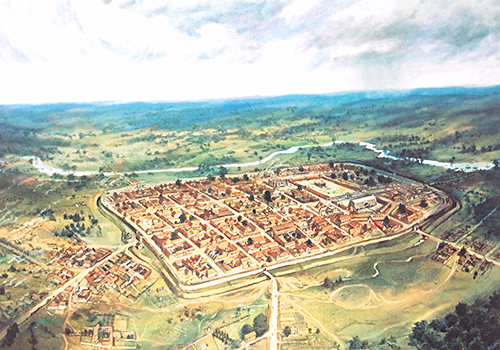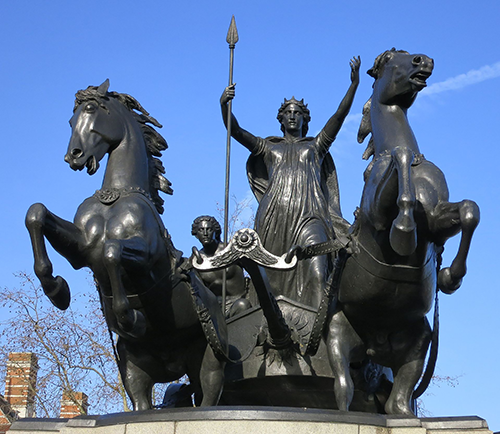




Boudica: The Warrior Queen and Her Rebellion
Boudica, ( other spellings include Boadicea, Buduica, and Bonduca) the legendary queen of the Iceni tribe, remains one of the most famous figures in ancient British history. Her rebellion against Roman rule in AD 60 or 61 was a defining moment in the history of Britain’s struggle against the Roman Empire. Known for her fierce leadership, Boudica led her forces in a series of devastating battles against Roman settlements, leaving a lasting legacy of resistance. Below is a detailed account of her life, the events leading to her rebellion, and the major battles that defined her campaign.
Boudica’s Background and the Spark of Rebellion
Boudica’s background is both fascinating and tragic, and it provides a critical foundation for understanding the rebellion she led against the Romans. A strong and determined woman, she rose from being a queen of a relatively peaceful tribe to a legendary figure who defied one of the most powerful empires in the world. To fully grasp the spark of her rebellion, we must first examine her background, her tribe, and the key events that led to her revolt.
The Iceni Tribe
Boudica was the queen of the Iceni, a tribe located in the eastern part of what is now England, primarily in modern-day Norfolk, Suffolk, and parts of Cambridgeshire. The Iceni were a Celtic tribe, part of the broader group of Britons, who, before the Roman invasion, had a rich culture and a strong warrior tradition. Like many Celtic tribes in Britain, the Iceni were skilled in warfare and fiercely protective of their independence.
The Romans had invaded Britain in 43 AD, and by the time of Boudica’s revolt in the early 60s AD, Roman control over southern Britain was largely secured. The Roman Empire had established its presence throughout the region, building roads, forts, and towns. Many of the tribes, including the Iceni, had been either conquered or had entered into treaties with the Romans in exchange for peace and relative autonomy.
At the time of Boudica’s revolt, the Iceni had enjoyed a relatively favorable relationship with Rome, largely due to their king Prasutagus. The Iceni had not been forcibly conquered like other tribes, but rather, Prasutagus had negotiated an alliance with Rome. He recognized the power of the Roman Empire and sought to maintain his tribe's independence through cooperation rather than conflict.
King Prasutagus and His Relationship with Rome
King Prasutagus ruled the Iceni for many years and, during his reign, the tribe’s relationship with Rome was relatively peaceful. Prasutagus had recognized the might of the Romans and, in an effort to preserve his tribe’s freedom, had come to an arrangement with the Romans. In his will, Prasutagus left his kingdom to his daughters and the Roman Emperor Nero, effectively making Nero a co-ruler of the Iceni. The intention behind this was clear: Prasutagus hoped that by formally linking his family with the Roman Emperor, the Romans would honor his wishes and allow his daughters to inherit and rule the Iceni kingdom after his death.
Prasutagus’s decision to share control of his kingdom with the Emperor was an attempt to ensure the survival of the Iceni tribe and its people. However, this decision would prove disastrous after Prasutagus’s death. The Romans, who had already established a presence in the region, were determined to assert their authority over the native peoples, even if that meant disregarding existing agreements and the autonomy of local rulers.
The Death of Prasutagus and the Roman Breach of Trust
Upon the death of King Prasutagus, his will was ignored by the Romans. The Roman authorities, rather than respecting the terms of the king’s will, saw it as an opportunity to assert their dominance over the Iceni and their surrounding tribes. The Roman governor of Britain at the time, Suetonius Paulinus, and his officials, believed that Prasutagus’s attempt to maintain power through his daughters was an affront to Roman authority.
Roman soldiers confiscated Iceni lands and property, effectively annexing the kingdom. The Roman authorities, led by officials who were either insensitive or unaware of the local customs and the importance of kingship to the native tribes, treated the Iceni with complete disregard. In addition to this, the Romans also subjected the Iceni people to harsh treatment. Boudica, as the wife of the late king, was treated cruelly, as were her daughters. According to the Roman historian Tacitus, Boudica was publicly flogged by the Romans. This physical humiliation was compounded by the violation of her daughters, who were raped by Roman soldiers.
The brutality of these acts—Boudica's flogging, the rape of her daughters, and the seizure of her people’s land—became the spark that ignited her rage and led to the rebellion. The personal affront to Boudica, combined with the mistreatment of her people, turned what may have been a minor grievance into a fierce and all-consuming desire for revenge. These acts of cruelty were not only deeply personal for Boudica but were also seen as an insult to her tribe's honor and autonomy.
The Call to Arms and the Gathering of Support
Boudica, devastated and enraged by the loss of her husband, her dignity, and the betrayal of her people by the Romans, called upon the Iceni and other discontented tribes in Britain to join her cause. According to Tacitus and Dio Cassius, two Roman historians who chronicled the revolt, Boudica was not only a symbol of defiance but also a charismatic and powerful leader. She was able to rally many of the tribes of eastern Britain to her side, including the Trinovantes, a tribe that had also suffered under Roman occupation.
Her call to arms resonated with many other tribes who had been subjected to Roman taxes, land seizures, and the loss of autonomy. The Trinovantes, in particular, had been treated harshly by the Romans since their submission to Roman rule, and they were eager to join the revolt against their oppressors. Boudica’s leadership, fueled by her desire for revenge and the suffering of her people, united these tribes into a formidable force.
The Rebellion Begins
Boudica’s rebellion was marked by its speed and ferocity. Once she had gathered a significant army, Boudica and her forces marched south toward Roman-controlled towns. The rebellion quickly gained momentum as more and more tribes, fueled by Boudica’s leadership, joined the uprising. The Romans, caught off guard by the suddenness of the attack, had little time to prepare an adequate defense.

Camulodunum ( modern day Colchester Essex )
Battle of Camulodunum (Modern Colchester)
The first significant battle of Boudica’s rebellion took place at Camulodunum, the Roman colonia located in modern-day Colchester. This city had become a symbol of Roman authority and exploitation, as it was populated largely by Roman veterans and their families, who had been granted land that had been taken from local tribes. These veterans were often aggressive and dismissive toward the native Britons, further stoking resentment.
Boudica’s army attacked Camulodunum in the spring of AD 60, gathering support from nearby tribes, including the Trinovantes. Tacitus, the Roman historian, describes the attack as brutal and swift. The Roman defenders were unprepared for the sheer size of the attacking force, and the city fell quickly. Boudica’s forces destroyed the Roman buildings, looted the city, and killed the Roman inhabitants, including civilians and soldiers alike.
This initial victory struck fear into the Romans and sent a clear message that Boudica was a force to be reckoned with. The Roman governor at the time, Gaius Suetonius Paulinus, was in the west of Britain, engaged in military campaigns against the Welsh tribes, and was unable to immediately respond to the attack.
Battle of Londinium (Modern London)
After the destruction of Camulodunum, Boudica’s forces turned their attention to Londinium, the thriving Roman city and commercial hub located along the River Thames. Londinium was an important Roman settlement, and its fall would be a significant blow to Roman control in Britain.
The Romans had no choice but to abandon the city, as Suetonius Paulinus was still away, and the Roman military presence in Londinium was insufficient to mount a defense. Panic swept through the Roman inhabitants of the city, and many attempted to flee, leaving the city vulnerable.
Boudica’s forces entered Londinium, and the city was immediately overrun. As with Camulodunum, the Romans were slaughtered, and the city was set alight. Tacitus gives a harrowing account of the devastation, describing how both Romans and Britons perished in the flames. The scale of the destruction was vast, with the city reduced to ruins. The loss of Londinium was a significant blow to Roman control in Britain and showed the power of Boudica’s rebellion.

Statue of Boudica and her Daughters near Westminster Pier
Battle of Verulamium (Modern St Albans)
Following the destruction of Londinium, Boudica’s army continued to rampage through Roman Britain, capturing and destroying several towns. The next major target was Verulamium, the Roman settlement in modern-day St Albans. Like the previous cities, Verulamium had been a Romanized town, heavily populated by Roman settlers.
Tacitus describes the siege of Verulamium as being especially brutal. The defenders, though aware of the approaching threat, were unable to mount a successful defense against Boudica’s massive force. The city fell into chaos, and once again, the Romans were killed indiscriminately. The town was thoroughly looted and destroyed, with the flames consuming the settlement.
Verulamium’s fall was significant, as it was one of the most important towns in Roman Britain. The destruction of the city further solidified Boudica’s reputation as a powerful and relentless opponent of Roman rule. However, this victory, like those at Camulodunum and Londinium, was part of a series of rapid and violent attacks that were beginning to stretch Boudica’s forces thin.
The Battle of Watling Street
The final and most decisive battle of Boudica’s rebellion took place at Watling Street, a Roman road that ran across Britain from the southeast to the northwest. By this point, Boudica’s forces had grown enormously, with estimates of their numbers ranging from 100,000 to 230,000 warriors. In contrast, Suetonius Paulinus had a much smaller, more disciplined force of around 10,000 Roman soldiers.
Suetonius chose a location for the final confrontation where Boudica’s massive numbers would count for little. The battle took place in a narrow defile, where the Roman soldiers could defend their position using the terrain to their advantage. The Roman army, although vastly outnumbered, relied on their superior military discipline, training, and tactical advantage.
The Romans formed a defensive line and, as Boudica’s forces advanced, the Romans attacked with their famous formation techniques. The Celts, though brave and numerous, were disorganized and poorly equipped compared to the disciplined Roman legions. Tacitus describes the carnage that ensued, with the Romans cutting down wave after wave of Celtic warriors. Boudica’s forces were decisively defeated, and the battle marked the end of her revolt.
Aftermath and Boudica’s Death
Following the defeat at Watling Street, Boudica’s army was scattered. The Romans launched a series of brutal reprisals against the surviving rebels, and thousands of captured warriors were either executed or enslaved. The Roman historian Dio Cassius records that the Roman victory was followed by mass executions, and the fate of the remaining rebels was sealed.
As for Boudica herself, her fate remains uncertain. Some sources claim that she poisoned herself to avoid capture, while others suggest that she died from the grief of losing her rebellion. Her death marked the end of her revolt, and the Roman Empire swiftly reasserted its control over Britain.
Conclusion
Boudica’s rebellion, though ultimately crushed, was a significant moment in the history of Roman Britain. Her battles—particularly those fought at Camulodunum, Londinium, Verulamium, and Watling Street—demonstrate her leadership, strategic brilliance, and the widespread support she garnered from the native tribes. While she did not succeed in overthrowing Roman rule, Boudica’s courage and resistance made her a lasting symbol of defiance against oppression. Her legacy endures as one of the most powerful figures in British history, a warrior queen who fought for her people’s freedom against the might of Rome.
Boudica’s rebellion, though ultimately crushed, was a significant moment in the history of Roman Britain. Her battles—particularly those fought at Camulodunum, Londinium, Verulamium, and Watling Street—demonstrate her leadership, strategic brilliance, and the widespread support she garnered from the native tribes. While she did not succeed in overthrowing Roman rule, Boudica’s courage and resistance made her a lasting symbol of defiance against oppression. Her legacy endures as one of the most powerful figures in British history, a warrior queen who fought for her people’s freedom against the might of Rome.
Author: Simon Ellis
Date: 11th, January 2025
Date: 11th, January 2025


